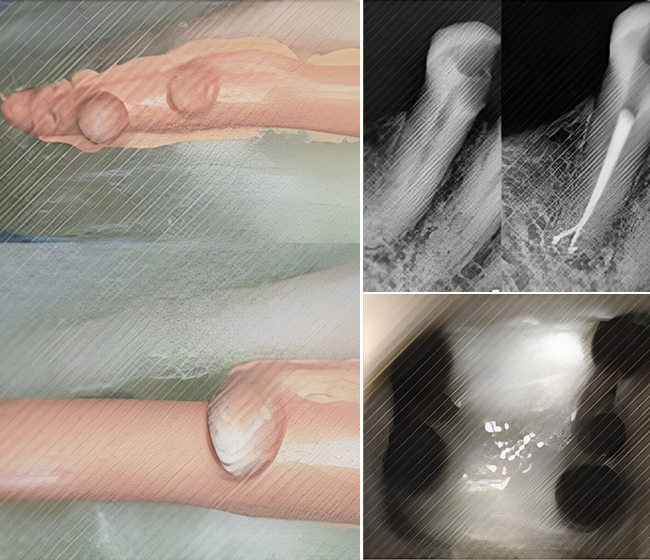
Root Canal Examination and Treatment Process
A clinical examination and a series of tests that include digital radiographs will be performed to isolate your chief complaint of pain to a specific tooth requiring treatment. The determination that there is enough tooth structure to save and ultimately restore the tooth to function will be made. Most "routine" root canal procedures can be performed in one appointment (2 hours or less); however, there are situations where two appointments are necessary to ensure sterility of the canal space before completion of the case. These include retreatments, cases where the pulp is necrotic or where there is an abscess evident at the base of the root. Intracanal medicaments are left within the canal space for one to four weeks between appointments to facilitate the elimination of all residual bacteria before sealing the root canal space.
Access
An opening is made in the back or top of the visible portion of the tooth (the crown) to gain entry into the root canal system. The use of loupes or microscopes to enhance magnification and illumination is essential in identifying the complex morphology of the root canal system.
Instrumentation
(Shaping and Cleaning of the Root Canal Space)
The preparation of the root canal space is performed to the end of each root. The added flexibility of nickel-titanium files (small wire like instruments) and irrigation (continuous flushing) is used to remove tissue, debris, and bacterial contamination. The length of the tooth is determined either by a computer assisted device or by x-rays.
Various medications and ultrasonic instruments are used to sterilize the tooth structure of the root canal system. All instruments used within the canal are used only once. The other instruments again, such as the dental drills, are autoclaved and sterilized with the most sophisticated equipment available.
Obturation
(Filling the Root Canal Space)
This step involves placing a thermo-softened filling material (gutta-percha) along with a sealing cement to fill the canal(s) and prevent future contamination. This material is injected into the canals and condensed with special instruments to create a perfectly adapted and impervious seal in the root canal system. In the radiographs, this polymeric material appears as the white area within the root canal space.
Restoration
(Crown or Inlay)
After the endodontic treatment is completed you will be referred back to your general dentist for a final restoration such as a crown, cap, or inlay/onlay. Your family dentist is best qualified to determine the best restoration to use to restore your tooth. A note and a copy of your final digital x-rays are sent by our office to your dentist, informing them that treatment has been completed.
Re-evaluation Appointment
You will be asked to return to our office in 3 to 6 months so that we may review the success of the root canal procedure. There is no additional charge for this visit.
Post Operative Discomfort
The nature and degree of discomfort experienced after root canal therapy depends upon a number of factors; the original diagnosis, your unique reaction to dental trauma, the amount of pain you had prior to treatment, and the amount of manipulation necessary to treat the tooth. A regimen of anti-inflammatories, analgesics and antibiotics may be required and should be taken as directed. The tooth is expected to be sore when chewing for up to a week after treatment. To help diminish this discomfort, the 'bite' on the tooth may be relieved from occlusion and you are asked to avoid the side while eating until it is comfortable again.
Alternative treatment options
If you are not committed to having the tooth properly restored after the root canal procedure and you do not mind the thought of losing a tooth, then endodontic therapy may not be the treatment of choice for you. Sadly, extraction is a short term fix with long term consequences. Teeth like every other part of our body were put there by a higher power for a reason. We have decided that they are expendable; the price incurred for this simplistic approach may ultimately prove very costly in the long run.
Review
We try our best to attend to you at the time reserved for your appointment; we are successful in the vast majority of cases. There are however, circumstances beyond our control which may preclude this possibility. We try our best to present the full scope of what you may expect from the treatment, however, in some cases, not everything plays out as expected. It is understood that endodontic treatment is a procedure to retain a tooth which may otherwise require extraction. Although this treatment has a very high degree of clinical success, it is still a biological procedure so it cannot be guaranteed. Occasionally a tooth which has had endodontic treatment may require retreatment, surgery, or even extraction. As previously indicated, once treatment is completed, your tooth will need a final restoration (filling, cap, or crown). Our fee does not include this service.

